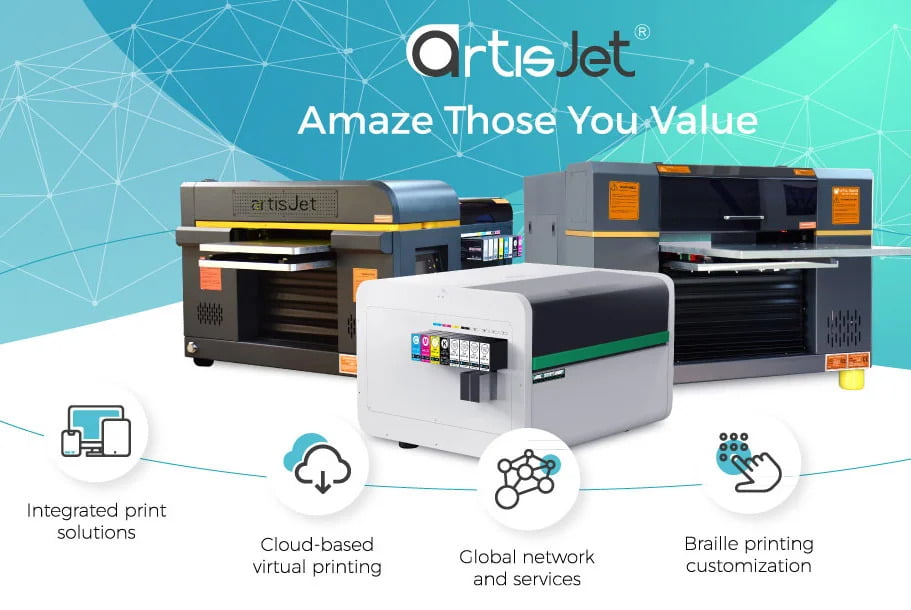UV Printers
Introduction to UV Printing with ArtisJet printers
The Ultimate Guide to UV Printers: Revolutionizing Printing
In the constantly evolving world of printing technology, UV printing has emerged as a revolutionary method that offers unparalleled benefits over traditional printing techniques. Ultraviolet (UV) printers, employing ultraviolet light to cure or dry ink as it’s printed, have transformed how businesses approach printing tasks. This comprehensive guide delves into the workings, benefits, and groundbreaking technology behind UV printing, providing insights into why it’s become a preferred choice for a wide range of printing needs.
Understanding UV Printing and Its Mechanics
At the heart of this technology lies a simple yet profound process. Unlike conventional printing methods that rely on solvent evaporation or absorption into the substrate, UV printers use a unique method where the ink is instantly cured (dried) by ultraviolet light the moment it hits the paper or substrate. This is achieved through the use of special inks that are sensitive to UV light. When the ink is exposed to UV light, it undergoes a photochemical process that turns it from a liquid to a solid state without the phase of being absorbed or evaporated. This instant curing is what sets UV printing apart, offering a smudge-free and highly detailed print quality that is unmatched.
The Benefits of UV Printing
The advantages of UV printing technology are vast, making it a compelling choice for businesses and individuals alike. Here are some of the key benefits:
- Durability and Quality: UV prints are known for their exceptional durability and resistance to fading, moisture, and wear. The instant curing process ensures that the ink doesn’t spread, resulting in sharper and more vibrant prints. UV ink printing doesn’t always yield flawless results. Occasionally, it may be necessary to apply a fixing agent to the print surface to improve adhesion and prevent the ink from peeling off over time. Artisjet offers both standard UV ink and water-based UV ink options. The choice of ink largely depends on the specific printing needs of the customer. The experts at MaxLaser are available to advise on the most suitable ink option for your project, and we can also provide demonstration prints using both types of ink to help determine the best fit for your application.
- Versatility: One of the most significant benefits of UV printing is its versatility. UV printers can print on a wide variety of substrates, including plastics, glass, metal, and more, opening up a world of possibilities for printing on non-traditional materials. The ArtisJet UV printers boast a versatile feature where the printing bed can be lowered. This z-axis adjustment capability allows for a drop of 170mm on the 3000 model and 250mm on the 5000 model, facilitating the printing on elevated objects like boxes, bags, and other items.
- Eco-Friendly: UV printing is more environmentally friendly compared to traditional methods. The process produces fewer volatile organic compounds (VOCs), requires less energy, and reduces waste, making it a sustainable choice. In this process, only ink is used, eliminating the need for vinyl materials typically required in traditional sticker applications on products. This approach also contributes to making the UV printer a more eco-friendly option.
- Speed and Efficiency: The instant curing of the ink not only ensures high-quality prints but also allows for faster printing speeds. This efficiency is perfect for businesses that require quick turnarounds without compromising on print quality.
How UV Printers Work
UV printers are sophisticated machines that consist of several key components: the inkjet printhead, UV ink, UV light sources, and the substrate holder. Here’s a simplified overview of the printing process:
- Inkjet Printhead: The printhead jets the UV-sensitive ink onto the substrate with high precision.
- UV Light Sources: As the ink is deposited, it’s immediately exposed to UV light from the built-in light sources. This exposure triggers the curing process, turning the ink from liquid to solid in milliseconds.
- Substrate: The substrate, which can vary from traditional paper to materials like plastic or metal, is held in place as the printing and curing occur.
This streamlined process is what enables UV printers to produce high-quality prints with remarkable speed and efficiency.
The Future of Printing
As we look towards the future, it’s clear that Ultra Violet printing technology is not just a passing trend but a mainstay in the printing industry. With ongoing advancements in this printing technology, we can expect to see even greater improvements in print quality, speed, and substrate versatility. Whether for business marketing materials, personalized items, or industrial applications, UV printers offer a compelling solution that meets the demands of modern printing needs.
In conclusion, the advent of UV printing technology represents a significant leap forward in the printing world. Its ability to produce durable, high-quality prints on a variety of substrates, combined with its eco-friendly and efficient process, makes UV printing a revolutionary choice for businesses and individuals alike. As we continue to witness the evolution of ultraviolet printing technology, one thing is clear: UV printers are here to stay, transforming our printing capabilities in ways we’ve only begun to explore.

